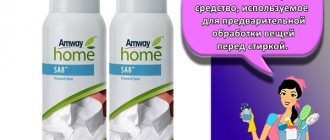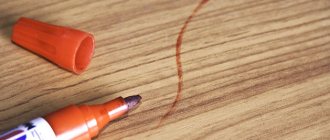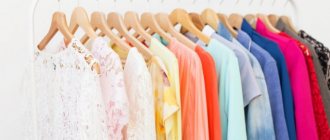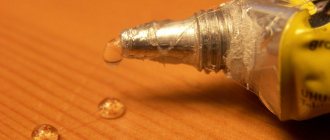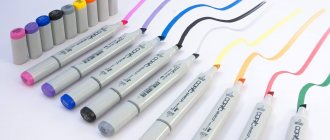| How to replace an eraser | Description |
| Office proofreader | At home, instead of a pencil eraser, many people prefer to use a stationery proofreader or a stroke. It is available in liquid and dry form. A proofreader allows you to accurately correct what has already been written on paper. It is enough to simply cover up the mistake carefully. The substance dries quickly on the surface of the sheet. Forms a thin, light-colored crust with a matte surface. The necessary correction can be written at the top. |
| Blade | If you need to correct a small mistake, many people prefer to use an old blade instead of an eraser. Its tip should be carefully wiped in the right place. It is important to do everything carefully, without damaging the sheet, otherwise such an adjustment will look very untidy. |
| With a sharp knife or scissors | A sharp knife or nail scissors can also be used to remove the error on the sheet. All manipulations must be done with the tip of the tool, without exerting strong pressure on the paper, otherwise a hole will simply form in this place. |
| Bread crumb | To erase the line of a graphite pencil before erasers appeared, it was customary to use bread crumb. The task is best accomplished by a crumb of dry black bread without a rough crust. Many people also use the soft white crumb of the bun. It helps clean up pencil marks that are often left behind when shading. |
| Nag | This stationery is well known to artists. At its core, it is also an eraser, but it has a soft, doughy texture. The nag can be easily wrinkled. It cleans the sheet well and has excellent absorbent properties. |
A pencil eraser is one of the most common office supplies that you always have on hand.
They can easily correct small blots in text or drawings; in case of unforeseen circumstances, you should know what you can use to replace the eraser at home.
How to remove a pencil from a painted wall?
Vinegar is one of the most effective ways to remove crayon from painted walls. The acetic acid in vinegar breaks down both the wax and pigment components of the pencil mark. If it works on your surface, this chemical reaction can save a lot of effort in cleaning.
Interesting materials:
How to change the country on Aliexpress? How to change the country on Netflix? How can I view results in other countries? How to divorce your husband if your marriage is registered in another country? How to change country in Blizzard? How to change country in Google Chrome? How to change country in iTunes? How to find out if there is a ban on leaving the country? How to find out the country of manufacture of Michelin tires? How to access YouTube from another country?
How can I remove it?
You can remove pencil marks in different ways. Of course, the very first one is using an eraser for drawing. But he will not always cope with the task. Available products, solutions prepared at home, and even food products can come in handy.
Artistic eraser
It is important to be careful at this point. Many adults believe that all erasers are the same and serve the same purpose. It is important to choose an art eraser, and not the one that is in every student’s pencil case.
The drawing eraser has a soft structure. Thanks to this, pencil marks are removed efficiently and carefully. The soft eraser erases pencil without damaging the wallpaper.
You can remove lines using standard pencil erasing movements. If necessary, go over the drawing twice so that nothing remains. The quality of artistic rubber bands is good and the cost is low.
Regular boiled egg
An old proven method for removing marks on wallpaper. There is an egg in every person's kitchen. The removal technique is as follows:
- The egg is boiled until the yolk is completely set.
- It must be warm before use.
- The shell is peeled off the egg and it is cut in half.
- Apply the inner side to the dirty area.
After a few minutes the egg is removed. Soft and warm, it absorbs pencil marks. As a result, the wallpaper becomes clean.
Soap solution
This option is suitable if the drawing was made recently and the lines are still “fresh”. Soap is diluted in warm water. A sponge is moistened in the prepared solution and used to treat the walls. Homemade cleaner does not harm wallpaper.
See also
How to quickly remove brilliant green from skin, 25 methods of removal using chemicals and folk remedies
Melamine sponge
This device should be in the arsenal of every family. Helps out in different situations. Working with a melamine sponge is no different from working with an eraser. Easily and quickly washes dirty wallpaper.
A melamine sponge can remove marks from a ballpoint pen.
Old toothbrush
The cleaning option is suitable in cases where gentle methods do not give the desired result. You can wipe off pencil marks using washing powder and a toothbrush. The steps are as follows:
- Mix powder and water in a small container. It should be a thick paste.
- Apply a little product to the brush and work the wall in a circular motion.
- If the area is clean again, the remaining powder and water are removed with toilet paper or a napkin.
An old toothbrush can be replaced with a cloth or sponge. In the latter case, the hard side is used rather than the foam side.
Solvent
This option is more suitable for vinyl wallpaper. Depending on the size of the pattern, a cotton swab, cotton pad or piece of gauze is selected. The selected “tool” is wetted in the solvent, and then follow the standard steps.
Iron or hair dryer
A method for parents whose children have painted wallpaper with wax crayons. The purpose of the method is to heat the wax so that it can be easily removed from the walls. This could be an iron, hair dryer or other heating device. Remains of wax are removed with a natural cloth.
What eraser erases colored pencils?
The best choice for erasing colored pencils is the so-called “knead” eraser. This eraser is a special cleaning rubber that tends to wrinkle easily in your hands. The good thing about klyachka is that it has a very soft consistency that resembles dough and has high absorbent properties.
Interesting materials:
How to get to Quileg? How to get to the City Beyond the Wall location? How to get to the Underdark? How to get to Turkmenistan from Russia? How to get better? How to plant hibiscus in a pot? How to plant carrots with sand? How to plant peonies from cuttings? How to plant rosemary at home in a pot? How to calculate the update factor?
Hard sponges
When special metal sponges appeared on sale, capable of removing serious stains not only from dishes, parents all over the world rejoiced. Now they could easily scrub the stain off many surfaces. You will probably need to work hard to clean a textured surface. Don't worry, you can do it! You should not take risks and use such a product to clean glossy or sparkling walls, because the consequences will be disappointing. Test your product the first time in a safe place.
Remember that if you rub a stain on a shiny surface, it will no longer shine as much. It is better then to use one of the methods presented above, which is suitable for the texture of your wall.
What kind of fabric
To understand what an eraser is and why it is so good, imagine a dense, silky-to-touch material consisting almost entirely of natural plant (cotton) raw materials. Traditionally, the material is used to make clothing for children or adults, sleeping linen, and other types of textiles for the home and interior.
A little historical background
The name of the fabric is similar to the name of the school eraser - “eraser” and with another textile material - elastic. It is precisely by such associations that the consumer imagines a stretchy, elastic fabric. However, in fact, the material received such a name not at all because of the erasing rubber bands and not because of the ability of rubber or caoutchouc fibers to stretch greatly (which are not included in the composition at all).
In English the word is written lasting, the translation into Russian is “durable”, and this is the main characteristic quality of the material being described. Unlike, for example, the same rib, with which an eraser is often confused, and which, like any knitwear, really stretches well.
Description
To accurately imagine what kind of fabric an eraser is, we offer a detailed description. This is a smooth, durable, pleasant-to-touch textile with a smooth surface. The characteristics correspond to any 100% cotton fabric: hygroscopic, environmentally friendly, hypoallergenic and safe for health.
Chemical exposure
If the above methods do not help, or the surface of the contamination is large, then there are more radical measures to get rid of traces. This is a chemical exposure to the following substances:
Gasoline, acetone or nail polish remover. They penetrate the structure of the material and extract the wax. But there is a possibility of damage to the surface being cleaned. Therefore, before using these liquids, you need to see the reaction of the wallpaper or furniture in advance, apply a small amount to the area of contamination and wait. If the material is not damaged, then you can proceed to eliminating the contamination.
- You can try to clean wallpaper or floors using household chemicals. These are glass washing liquids, gels, stain removers, their action is entirely aimed at removing stains, and they show good results. It is important to use household chemicals in accordance with the instructions provided.
- Shoe or fabric stores sell special stain removers and wax removers. They have a low cost, but have a pronounced effect. The liquids come with recommendations for proper use; they must be followed, and then the stain will quickly disappear.
What is made from fabric and how to care for it?
Traditionally, this lustrous, durable and relatively inexpensive fabric was used as a lining for outerwear. In addition, bed and table linen, curtains, and various decorative textiles are made from it. This hygienic and beautiful cotton material is used for sewing men's shirts, pajamas, light women's and children's clothing. The shiny bright eraser is very suitable for elegant and wear-resistant stage costumes, especially in folk style, as well as various accessories and decorations.
The rules for caring for an eraser are the same as for other cotton fabrics. It can be washed either by hand or in a machine. This textile is resistant to all washing modes, but it is better to wash dyed and printed fabrics at a temperature of no more than 40 degrees, without using bleaches. Even for bleached fabric, the first wash should be done at this temperature to avoid shrinkage. The eraser is not afraid of machine spinning and machine drying, and when drying in the fresh air it must be carefully straightened to avoid creases. You should also avoid exposing it to sunlight.
Ironing of products made from this material is carried out in the “Cotton” mode. This operation must be carried out from the inside out, things should be slightly under-dried. Steaming can be used if necessary. Since the eraser absorbs moisture very well, products made from it should be kept in a dry place with good ventilation and under no circumstances should they be packaged in plastic bags.
Advantages and disadvantages of the material
All properties and consumer characteristics of eraser fabric are determined by its absolutely natural composition and the method of weaving the threads. The material has many advantages.
- The fabric does not contain dangerous additives, is created without the use of harmful chemical impregnations and is completely safe for health.
- The material is hypoallergenic and does not cause unwanted reactions or irritations.
- The 100% cotton material is highly breathable, allowing your skin to breathe freely.
- Cotton fiber has antibacterial properties, as it does not contribute to the proliferation of pathogenic microflora.
- The eraser is highly hygroscopic. Products made from this material can absorb up to 30% moisture, remaining dry to the touch.
- Thanks to the good thermoregulating properties inherent in any natural material, products made from eraser warm you up in the cold season and create a feeling of coolness in the heat.
- The fabric is very durable, retains its shape well, and almost does not shrink when washed.
It is impossible not to note some of the eraser's shortcomings arising from the structural features of the canvas. When sewing products, you need to choose the right thickness of needle and thread, otherwise you can cut through the fibers. In addition, the edges should be carefully processed, as the material crumbles a lot.
Mechanical methods for cleaning cardboard
The ink can be removed mechanically, but the stain will be erased along with the top layer of paper: the roughness on the sheet will remain forever. That is why the methods proposed below can only be used if the paper is thick.
Blade
Peculiarities. When using a razor, take special care to avoid cutting yourself.
How to act
- With the blade perpendicular to the paper, carefully scrape off any unwanted ink.
- Place the razor on the cleaned area with a glossy surface and sand.
Sandpaper
Peculiarities. You should use fine-grained sandpaper, “zero”.
How to act
- Using double-sided tape, stick a small piece of sandpaper onto the blunt end of any pencil.
- Gently wipe off excess ink without pressing too hard.
- Blow off “side” particles.
- Smooth the surface of the paper with your fingernail.
Band-Aid
Peculiarities. It is most convenient to use a narrow adhesive plaster.
How to act
- Place a small piece of adhesive tape over the ink being removed.
- Peel off carefully - the ink will come off along with the top layer of paper.
Is it possible to wash Nag?
Before use, the nag must be kneaded in your hands, especially if it is hard. ... They often ask, is it worth washing the nag? Unfortunately, it won't be possible to wash it off. If it becomes very dirty, it must be replaced.
Interesting materials:
What should you do if water gets into your ear and won’t come out? What to do if Wi-Fi is connected but the Internet does not work? What to do if you were fired and not paid? What to do if your neighbors flooded you? Legal advice? What to do if your flight is delayed and you miss another? What to do if the web page is not available on the phone? What to do if the thing is painted? What to do if the item is dyed after washing? What to do if the item is dyed during washing? What to do if the item is painted?
An aerosol cleaner like WD-40
Many aerosol car rust cleaners do a very good job of removing stains, so getting rid of crayon residue on your wall won't be a problem! Take the product and apply it to the stain, then wipe it off, and voila, the stain is gone!
Colored pencil, as a rule, disappears literally immediately. For hard-to-wash or long-standing crayon, more patience may come in handy. The WD-40 series has a special marker-cleaner for cleaning and destroying stains, which also helps a lot with removing stubborn stains.
WD-40 works very well on stains on painted surfaces. It is important not to use a spray as it will add even more stains. You'll need to wash the oily residue off the walls after you've removed the crayon stains. In addition, they can easily remain on the carpet or your clothes, and this will become your worst nightmare, because it is extremely difficult to remove such stains. Consider adding a few drop cloths to protect nearby surfaces.
Removal by chemical means
You can use nail polish remover or replace it with gasoline, stain remover, glass cleaner, or acetone. A cotton pad is used for application.
All substances contain aggressive components, so their use on colored wallpaper is not recommended. There is a risk of fading.

